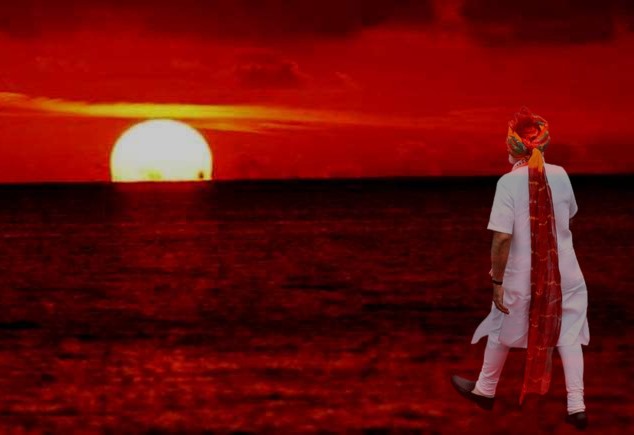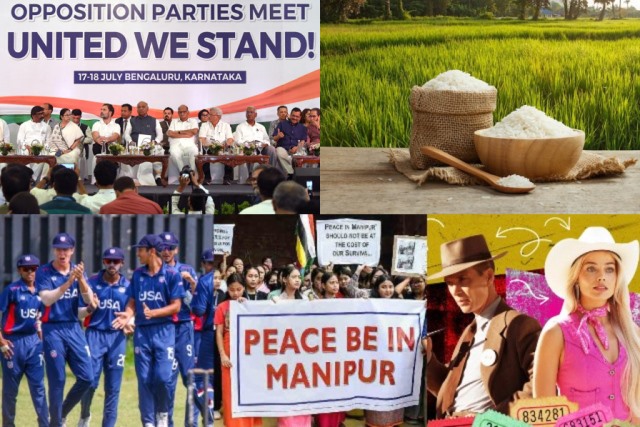Almost 75 in a nation of the young and aspiring, the cynics are of the considered view that the PM should perhaps consider joining the ‘Margdarshak Mandal’ of his party, along with luminaries like his mentor, LK Advani, and Murli Manohar Joshi. There is a time to arrive and celebrate, and there is a time to go, as the song goes. Or else, history might repeat itself in a pattern so predictable and pathetic that even immortality would seem commonplace, as Argentine poet and short-story writer, Jorge Luis Borges would say.
Not only the eerie silence on a ravaged Manipur, which continues to be trapped in tragedy till this day, and the hounding and harassment of our world champion women wrestlers while protecting a BJP bahubali from UP, all the trump cards seem to be collapsing for the Hindutva regime in Delhi. The ‘nafrat ka bazaar’ seems to have no buyers, and the ‘mohabbat ki dukaan’ seems to be resurrecting yet again in a country brutalized by the vicious ‘acche din’ — since the ill-fated, hate-filled, scorching summer of 2014.
The Uniform Civil Code card failed so abysmally that it did not even take off. The organized Nuh-Gurgaon communal polarization, in what has been a historically peaceful social co-existence, was yet again countered by the farmers, and so effectively, with their huge mahapanchayats, that the sublime synthesis of ‘Har Har Mahadev’ and ‘Allah-o-Akbar’ sweetened the air like the sweet smell of melting jaggery in the lush green fields of western UP. The farmers have yet again played such a resilient, path-breaking and visionary role in this era of hate politics that their contribution will be written in golden letters in the history of our times.
Now, they seem to be riding on the ‘double-engine’ of a ‘one-nation-one election’ syndrome, after their partisan ‘double-engine’ regimes have behaved with such grotesque and willful irresponsibility in Manipur and Haryana. So, is the fake messiah not sure of his one-dimensional, money and muscle powers anymore?
Bihar Deputy Chief Minister Tejashwi Yadav has responded with sound rhetoric: “Prime Minister Narendra Modi is talking about ‘one nation, one election’ now. He will later talk about just central elections and do away with the need for state elections. He will then assert, ‘one nation, one party’, ‘one nation, one leader’, ‘one nation, one language’, ‘one nation, one pehelwan (strongman)’, ‘one nation, one religion’. These are useless things. These will not be successful.”
So, will the PM also win Rajasthan, Chhattisgarh, Madhya Pradesh and Telengana – where the Congress seems poised for a decisive victory? Besides, will he also ride the glorious chariot of victory in Punjab, Himachal Pradesh, Bengal, Andhra Pradesh, Tamil Nadu, Karnataka, Delhi, Maharashtra and Kerala? And what about Jammu and Kashmir — where he and his party has played all their cards wrong, and unleashed such mass suffering — will he hold assembly elections out there, with or without Article 370? Indeed, without UP and Gujarat, what does the BJP have to score decisive victories against INDIA?
ALSO READ: High Time Adani Group Was Investigated In India
Contrary to those perennial cynics who are actually playing a dubious game for the BJP, all seems to be well with the INDIA alliance. As for the contentious issue of one-to-one seat- sharing, this has been in the process of finalization since the early dialogue led by Nitish Kumar with opposition leaders. The Congress has constantly pushed forward the spirit of consensus and flexibility, and, even this time, Mamata Banerjee was seen engrossed in conversation with Rahul Gandhi, while, she, yet again, greeted Sonia Gandhi with great warmth.
Even Akhilesh Yadav seems to have upped his ante, including on social media, and with the participation of Jayant Choudhury, leader of RLD in western UP, they will once again give a tough time to the BJP, which, anyway, had no ground support among the farmers in this fertile, green revolution belt. It is only after the socially engineered, polarizing violence unleashed before the 2014 Lok Sabha polls, that a peaceful western UP witnessed hate politics for the first time.
After the successful Mumbai meeting, Nitish Kumar said, “There is no problem with seat-sharing. We are talking among ourselves. Internally, everything will be done very soon. Don’t worry about these things. We will do it and then let you all know. We have decided to finalise everything this month.”
If anything, the recent assembly results for the bypolls are signs of an unhappy narrative unfolding for the ruling party. INDIA has won four, the BJP three, and that too in Tripura and Uttarakhand, which do not really count in the larger electoral battle. The Trinamool Congress has wrested back the Dhupguri assembly seat in West Bengal from the BJP. In Kerala, contesting against the strong and popular turf created by the late Oomen Chandy, the BJP has lost its deposit. And, most crucially, it has lost the bitterly contested seat of Ghosi in UP where the INDIA alliance fielded a joint candidate.
Meanwhile, there is more bad news coming for the crushed Hindutva brigade in Karnataka. RSS strategist BL Santosh, who botched it up so badly in the assembly polls, called a meeting of the party and its state leaders. Significantly, former chief ministers BS Yediyurappa and Basavaraj Bommai, former deputy chief minister KS Eshwarappa, BJP state president Nalin Kumar Kateel, Padmanabanagar MLA R Ashok and Mahalakshmi Layout MLA K Gopalaiah, and other leaders from Shivamogga district did not turn up. Besides, several BJP leaders are tipped to be keen to join the ruling Congress, even while the party seems totally rudderless in the state and in the assembly.
More so, the Modani shadow has yet again loomed large on the sinking fortunes of the PM and his best businessman buddy. Two of the most prestigious newspapers in the UK have reported on more shady deals and Rahul Gandhi wasted no time in hitting where it really hurts.
The Guardian headline said: ‘Modi-linked Adani family secretly invested in own shares, documents suggest’. The report was categorical: “Since the Hindenburg report was published, Modi has faced difficult questions about the nature of his partnership with Gautam Adani and allegations of preferential treatment of the Adani Group by his government.”
The Financial Times headline said, ‘Adani shares slide and politicians demand action after reports on hidden investors’. The report said, “The reports have shone a spotlight on Indian institutions and the relationship between the conglomerate’s founder, Gautam Adani, and Prime Minister Narendra Modi, in a febrile atmosphere ahead of elections early next year.”
Now, accusing George Soros’ Open Society Foundations, would be meaningless. The democrat-philanthropist-industrialist is not the only donor to the Organized Crime and Corruption Reporting Project (OCCRP), a collective of investigative journalists that worked with the Financial Times and The Guardian. Itsdonors include, yes, the US State Department, the United Kingdom Foreign, Commonwealth & Development Office, the ministry of Europe & foreign affairs of France, and the ministry of foreign affairs of Denmark.
Hence, while Big Brother might be watching all over in India, the world, especially the West, too, is watching the rise and fall of a home-grown tyrant. While thousands of ordinary folks and daily-wagers might be losing their bread and butter during the lockdown unleashed due to the hyperbole around the G-20 summit in Delhi, there are transparent signals that the world powers are aware of a certain paradigm shift in India. While the poor people’s quarters were compelled to vanish, hidden with huge green sheets, even the streets were sanitised. Street dogs of Delhi were treated with such bestiality that it was heart-breaking. Wonder what they did with the holy cows of Hindutva wandering on the streets and eating all kind of junk from garbage bins?
Barring the stooge media, this is clearly reflected in the mood of the nation, as much as in the manner in which the Opposition alliance seems confident before the countdown of 2024.
Indeed, you don’t need a full moon night to see that the tide is rising in the horizon. It’s once again time for ‘khela hobe’. Surely, it’s time to get onto the other side.

